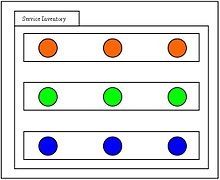Service layer pattern
This article relies largely or entirely on a single source. (April 2010) |
Service layer is an architectural pattern, applied within the service-orientation design paradigm, which aims to organize the services, within a service inventory, into a set of logical layers. Services that are categorized into a particular layer share functionality. This helps to reduce the conceptual overhead related to managing the service inventory, as the services belonging to the same layer address a smaller set of activities.
Rationale[edit]
Grouping services into functional layers reduces the impact of change. Most changes affect only the layer in which they're made, with few side-effects that impact other layers. This fundamentally simplifies service maintenance.
The service reusability principle dictates that services should be designed to maximize reuse. Similarly, the service composability principle advocates designing services so that they can be composed in various ways. Both principles require that a service contain only a specific type of logic e.g., either reusable or process-specific logic.[1] Restricting each layer to a particular functionality, simplifies the design of the service.
Usage[edit]

In the absence of any layers, services contain a mixture of different types of logic. This makes it difficult to manage these services.

A service inventory divided into layers where each layer contains the same type of logic.
Applying this pattern requires creating a service inventory blueprint, a list of services with associated functionality. Next, group the services into layers according to function. Adopting a common layering strategy across the enterprise facilitates reuse in other applications, because developers don't have as much to learn (or invent) when they join a project. One common layering uses task, entity and utility.[2]
An alternative layering from Bieberstein et al.,[3] involves five layers, namely enterprise, process, service, component and object.
The service layer pattern invokes a specific service architecture.
The top-down service delivery approach facilitates the use of this pattern.
See also[edit]
References[edit]
- ^ Thomas Erl.Introducing SOA Design Pattern [Online]. Date accessed:6 April 2010.
- ^ Wajid Khattak Service Layers [Online].Date accessed: 21 April 2010.
- ^ Bieberstein. et al.Service-oriented Architecture Compass: Business Value, Planning, and Enterprise Roadmap.FT Press, 2005. ISBN 0-13-187002-5, ISBN 978-0-13-187002-4
- Erl, Thomas (2009). SOA Design Patterns. Prentice Hall. ISBN 978-0-13-613516-6.
- Mauro, Christian; et al. (2010). Service Oriented Device Integration - An Analysis of SOA Design Patterns. HICSS 2010. 2010 43rd Hawaii International Conference on System Sciences. pp. 1–10. doi:10.1109/HICSS.2010.336. ISBN 978-1-4244-5509-6. ISSN 1530-1605. Retrieved 2020-07-26.
- Seshadri, Srikanth (17 January 2007). "Logically SOA". JavaWorld. Retrieved 2020-07-26.
- "Service-Oriented Architecture and Java - Service Layer". Technology. Binary Spectrum. Retrieved 2020-07-26.
- Bieberstein, Norbert; Jones, Keith; Laird, Robert G.; Mitra, Tilak (17 July 2008). "Executing SOA: A Methodology for Service Modeling and Design". InformIT. Retrieved 2020-07-26.
- "High-Level Perspective of the SOA RA". SOA Source Book. The Open Group. Retrieved 2020-07-26.
